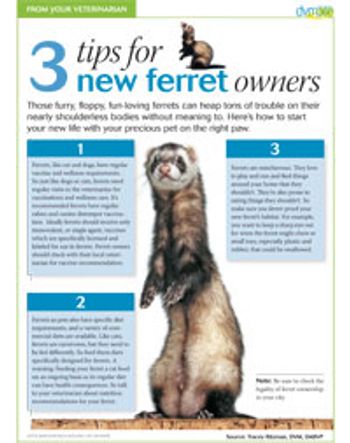
We've ferreted out three top tips to help you educate veterinary clients about their new furry friends. Click, print and share!

We've ferreted out three top tips to help you educate veterinary clients about their new furry friends. Click, print and share!

Those furry, floppy, fun-loving ferrets can heap tons of trouble on their nearly shoulderless bodies without meaning to. Help new ferret owners protect their furry little friends with these quick tips from Tracey Ritzman, DVM, DABVP.

Gastrointestinal diseases and disorders are common in avian patients. This presentation will give an overview of anatomy and clinical presentations of gastrointestinal (GI) disease in birds.

Neoplastic disease is a common clinical entity in exotic small mammals (rabbits, ferrets, rodents). Affected patients can exhibit a wide variety of clinical conditions.

Nutrition is the process by which birds and all other animals consume food items and utilize it in the body for growth, tissue replacement or repair and the continuance of life.

Hyperadrenocorticism is a common and complex clinical condition in the pet ferret.

The cloaca is a complex structure in the avian patient. Its primary function is the retention and expulsion of intestinal, reproductive, and urinary products.

The pediatric avian patient can present with a wide variety of clinical conditions, many of which are specific to this age group.

The ferret patient will often present in an emergency setting with acute presentation of either an acute or chronic disorder.

Published: October 1st 2008 | Updated:

Published: October 1st 2008 | Updated:

Published: October 1st 2008 | Updated:

Published: October 1st 2008 | Updated:

Published: October 1st 2008 | Updated:

Published: October 1st 2008 | Updated: